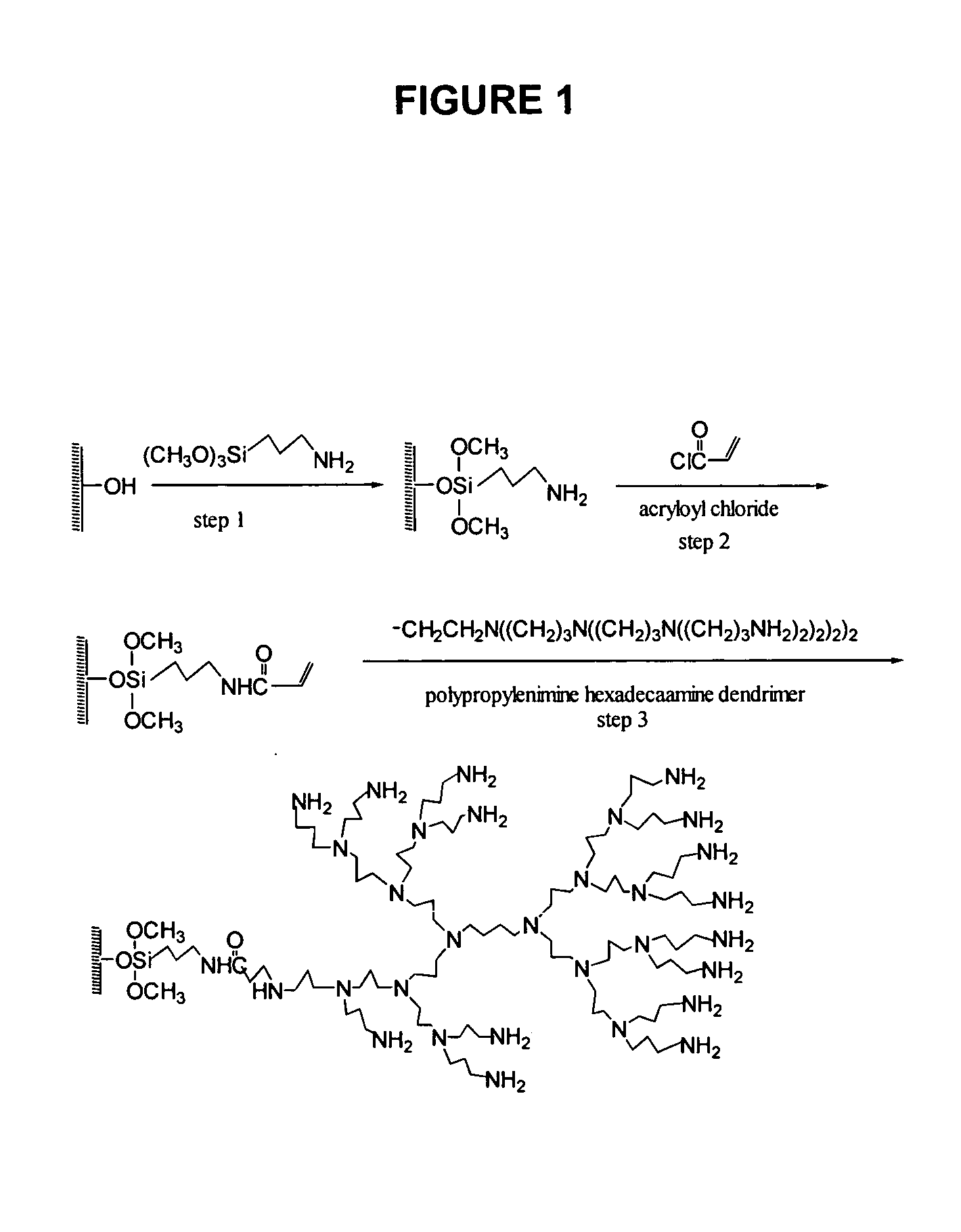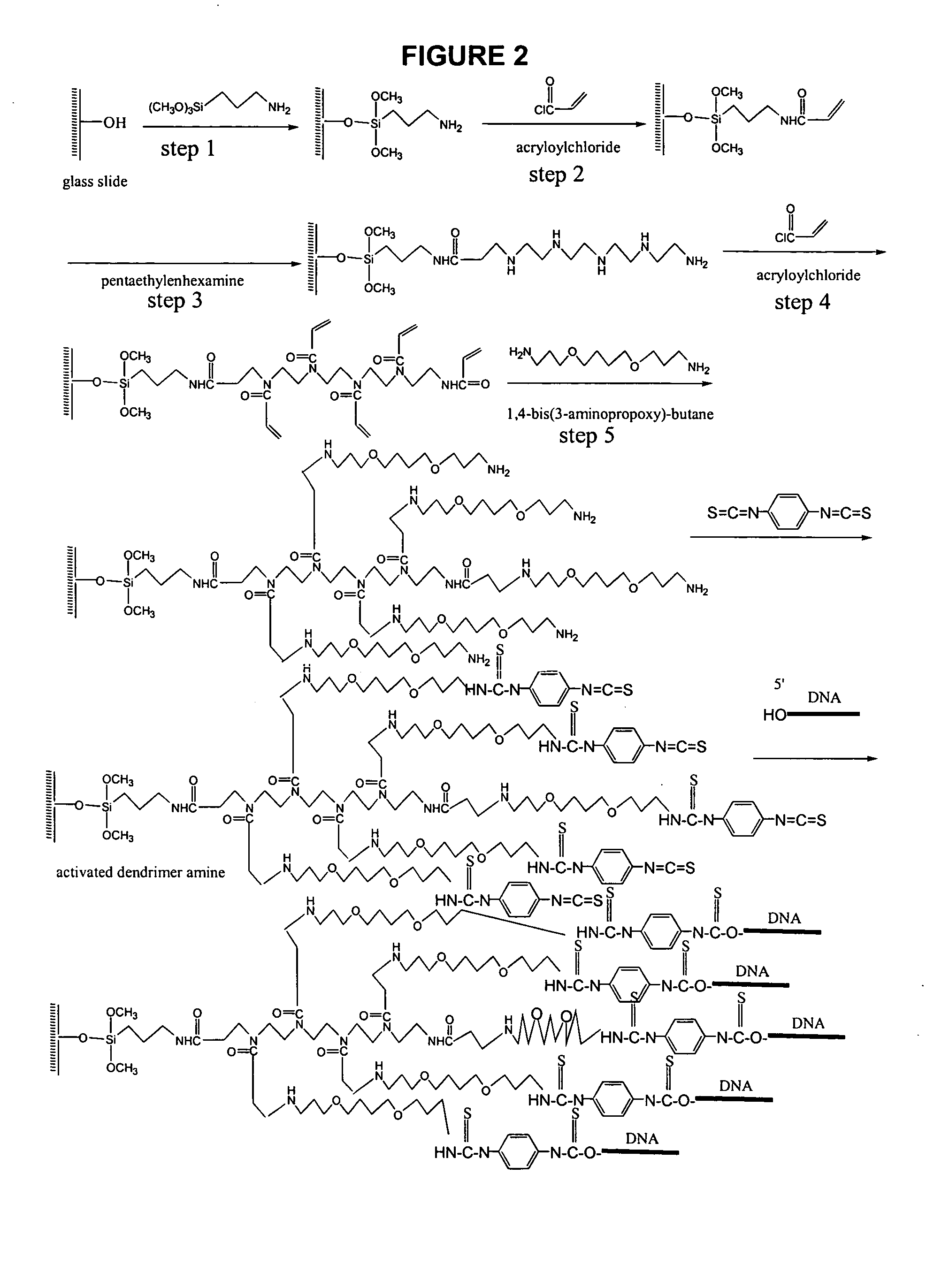Compositions and methods using dendrimer-treated microassays
a technology of dendrimer and microassays, applied in the field of microarray technology, can solve the problems of unfavorable probe molecule spreading, unfavorable microassay results, and unfavorable microassay results
- Summary
- Abstract
- Description
- Claims
- Application Information
AI Technical Summary
Problems solved by technology
Method used
Image
Examples
example 1
Production of Chemically Reactive Surfaces
Surface Modification with Preformed Dendrimer Polyamine
In a dust free area, 120 glass slides were placed into 6 polypropylene slide racks. The slides were examined to ensure there were no scratches, haze or other imperfections of the glass slides using the dissecting microscope. The slide racks were put into a 1.5 L polypropylene container and washed overnight with 100% ethanol with agitation. After rinsing with water, the slides were immersed in 10% aqueous sodium hydroxide solution overnight, followed by rinsing with water, 1% hydrochloric acid, water and then 100% methanol. After a 15 minute sonication in 1.5 L 95% methanol containing 3% aminopropyl trimethoxysilane, the slides were washed in methanol, water, and then dried under a stream of compressed air and heated at 110° C. for 15 minutes. The amine-silanized glass slides were incubated in a polypropylene container at room temperature for 2 hours in 1.5 L anhydrous dichloroethane ...
example 2
DNA Printing and Slide Deactivating
Unmodified probe DNA (specifically, actin, X56062, X14212, U91966, ssDNA, Cot 1 DNA, and a 73-mer oligonucleotide; see FIG. 3) were suspended in 5% aqueous sodium bicarbonate solution (pH 8.4-8.5) at a concentration between 0.5-0.0125 μg / μl. Preactivated dendrimer amine slides are loaded on an OmniGrid arrayer (GeneMachines San Carlos, Calif.) and the arraying chamber was brought to 25° C. with a humidity of 70-80%. After array printing, the slides were incubated at 37° C. for 36 hours at a humidity of 70-80%. The slides were rinsed with water and 100% methanol, then deactivated in 1.5 L DMF solution containing 40 mL of diisopropylethylamine and 8.76 g of 6-amino-hexanol-1 for 2 hours at room temperature. The slides were rinsed for 5 minutes with DMF, acetone and water (1 L each). The deactivating could also be carried out by the reaction of printed slides with 5% aqueous sodium bicarbonate (pH 8.4-8.5) or 5% of 4-aminobutyric acid in 5% aqueous ...
example 3
Hybridization to DNA Arrays
For hybridization with target oligonucleotides, fluorescently-labeled oligomer target (specifically, Cy3-labeled cDNA made from 33 μg of total HeLa RNA, or Cy5-labeled 73-mer (100 ng)) was put into 10 μl of solution containing 0.1% SDS, 0.8 μg / μl of polydA(40-60), 3×SSC, 0.4 μg / μl of yeast tRNA, 1 μg / μl of human Cot-1 DNA, 1 μg / μl of salmon sperm DNA. To generate the cDNA targets, RT / PCR products were labeled with 5′-Cy3 or Cy5 primers, or Cy dye labeled dUTP using standard protocols (Microarray Labeling Kit, Stratagene, La Jolla, Calif.). Starting with 10 to 33.3 μg of total RNA, the labeled cDNA target was purified by BioRad Spin-6 column (BioRad) or Microcon P-6 column, mixed in 10 μl of a solution containing 0.1% SDS, 0.8 μg / μl of polydA(40-60), 3×SSC, 0.4 μg / μl of yeast tRNA, 1 μg / μl of human Cot-1 DNA, 1 μg / μl of salmon sperm DNA. Hybridization was carried out in a humid chamber or under a cover slip (22×22 mm). The hybridization temperature was de...
PUM
| Property | Measurement | Unit |
|---|---|---|
| temperature | aaaaa | aaaaa |
| fragile | aaaaa | aaaaa |
| capillary forces | aaaaa | aaaaa |
Abstract
Description
Claims
Application Information
 Login to View More
Login to View More - R&D
- Intellectual Property
- Life Sciences
- Materials
- Tech Scout
- Unparalleled Data Quality
- Higher Quality Content
- 60% Fewer Hallucinations
Browse by: Latest US Patents, China's latest patents, Technical Efficacy Thesaurus, Application Domain, Technology Topic, Popular Technical Reports.
© 2025 PatSnap. All rights reserved.Legal|Privacy policy|Modern Slavery Act Transparency Statement|Sitemap|About US| Contact US: help@patsnap.com



